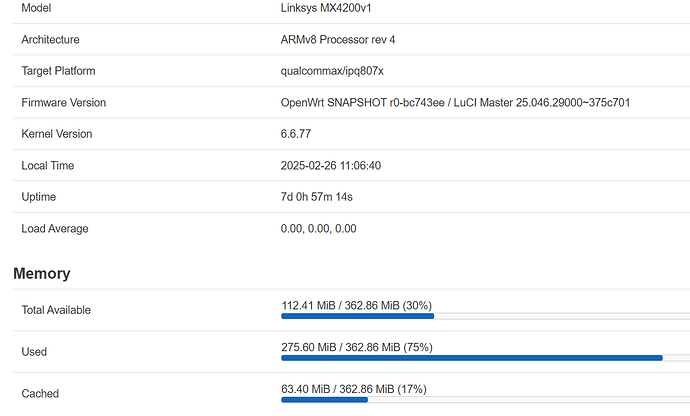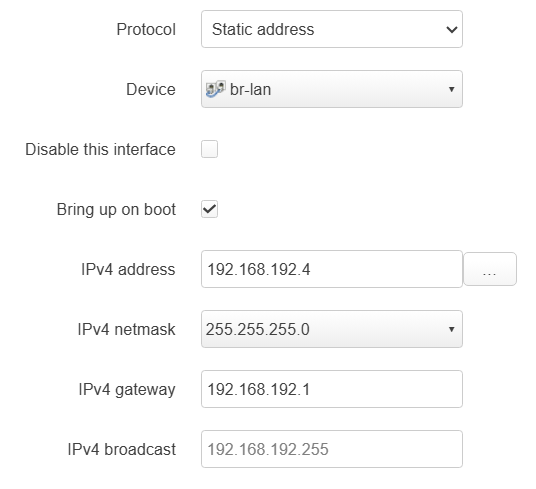A while back, I got 4 refurbished MX4200s for my club, and loaded them with a firmware generator image at openwrt-24.10.0-rc5-76ad83a73047-qualcommax-ipq807x-linksys_mx4200v1-squashfs-factory.bin. After I did that I noticed that one of them was using MAC addresses that weren't the factory assigned ones. It seemed to work OK but I set it aside, I only need 3 right now.
Later, I realized that router was actually an MX4200v2; I'd received 3 v1 and 1 v2 router. So I attempted to reinstall it with openwrt-24.10.0-rc6-d860b660a1b7-qualcommax-ipq807x-linksys_mx4200v2-squashfs-sysupgrade.bin but that resulted in something that wasn't responding on Ethernet.
Putting a serial console on that revealed that OpenWRT was booting, and doing a failsafe boot and factory reset got it working again. At that point, it was booting/running the v1 image.
I tried flashing the v2 images again, both factory and sysupgrade. The upgrade from GUI logs:
Sat Jan 4 21:37:41 UTC 2025 upgrade: Sending TERM to remaining processes ...
Sat Jan 4 21:37:41 UTC 2025 upgrade: Sending signal TERM to netifd (2016)
Sat Jan 4 21:37:41 UTC 2025 upgrade: Sending signal TERM to ntpd (3121)
Sat Jan 4 21:37:41 UTC 2025 upgrade: Sending signal TERM to ntpd (3188)
Sat Jan 4 21:37:45 UTC 2025 upgrade: Sending KILL to remaining processes ...
Sat Jan 4 21:37:45 UTC 2025 upgrade: Sending signal KILL to netifd (2016)
[ 138.707257] stage2 (3755): drop_caches: 3
Sat Jan 4 21:37:53 UTC 2025 upgrade: Switching to ramdisk...
[ 140.458268] UBIFS (ubi0:1): background thread "ubifs_bgt0_1" stops
[ 140.468004] UBIFS (ubi0:1): un-mount UBI device 0
Sat Jan 4 21:37:55 UTC 2025 upgrade: Performing system upgrade...
[ 141.230363] ubi1: attaching mtd24
[ 142.056460] ubi1: scanning is finished
[ 142.064558] ubi1: attached mtd24 (name "alt_rootfs", size 144 MiB)
[ 142.064604] ubi1: PEB size: 131072 bytes (128 KiB), LEB size: 126976 bytes
[ 142.069666] ubi1: min./max. I/O unit sizes: 2048/2048, sub-page size 2048
[ 142.076509] ubi1: VID header offset: 2048 (aligned 2048), data offset: 4096
[ 142.083361] ubi1: good PEBs: 1152, bad PEBs: 0, corrupted PEBs: 0
[ 142.090137] ubi1: user volume: 1, internal volumes: 1, max. volumes count: 128
[ 142.096396] ubi1: max/mean erase counter: 1/0, WL threshold: 4096, image sequence number: 1504320963
[ 142.103503] ubi1: available PEBs: 0, total reserved PEBs: 1152, PEBs reserved for bad PEB handling: 80
[ 142.112805] ubi1: background thread "ubi_bgt1d" started, PID 4569
UBI device number 1, total 1152 LEBs (146276352 bytes, 139.5 MiB), available 0 LEBs (0 bytes), LEB size 126976 bytes (124.0 KiB)
ubimkvol: error!: UBI device does not have free logical eraseblocks
cannot create kernel volume
sysupgrade failed
umount: can't unmount /dev: Resource busy
umount: can't unmount /tmp: Resource busy
[ 142.576458] remoteproc remoteproc0: stopped remote processor cd00000.q6v5_wcss
[ 143.084988] reboot: Restarting system
and then u-boot seems to fail at
NAND read: device 0 offset 0xa680000, size 0x600000
6291456 bytes read: OK
Wrong Image Format for bootm command
ERROR: can't get kernel image!
3 resets then bring it back to booting from the v1 image.
- Is there much harm in using the v1 image? Is there likely to be any other ill effect besides the unusual MAC addresses?
- I'm using these in a fairly simple router + APs config with 1 SSID. The v1 image detects the 1GB RAM OK, I won't have anything on the flash aside from a few packages. Are there any strong reasons to prefer v2?
- last, is there a not-too-painful way to install v2 in this situation?


